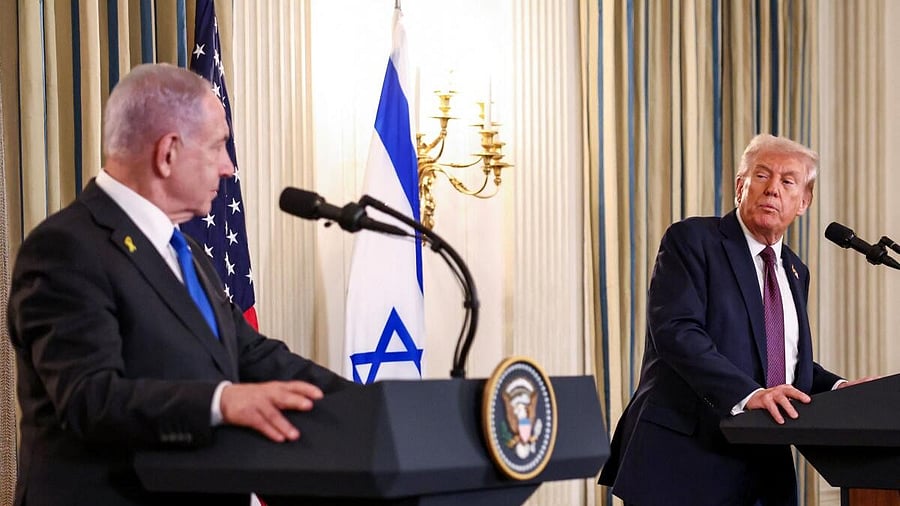
US President Trump meets Israeli PM Netanyahu at the White House in Washington
Credit: Reuters photo
By Marc Champion
When Donald Trump returned to office promising to end to the war in Gaza, he not unreasonably touted his first term success in negotiating the so-called Abraham accords between Israel and its Arab neighbors as proof he could do it.
But it seemed clear from the start that he would face a much tougher challenge this time, because the interests and roles of America’s friends in the region have changed so profoundly.
This has proved true in spades. Until recently there was little doubt that Israeli Prime Minister Benjamin Netanyahu had won the contest with Arab leaders for the US President’s ear. The result is that the war has continued, fueled in part by by US arms and diplomatic support for Israel. It took a fateful miscalculation on the part of Netanyahu to change the game, after he humiliated Trump and his team by bombing Hamas leaders in Qatar as they discussed a US peace proposal.
The result is the latest US peace plan, which — as I wrote last week — is the first produced under Trump to have a chance of uniting US allies in the Middle East around it. And while he has sold the deal as an ultimatum, he appears — so far, and to his credit — to have accepted that further negotiations with Hamas will be needed if essential missing details are to be filled in. The question now is this: Can the US president stay interested enough for long enough to see this through?
The diplomatic table has been correctly set for this. Trump will head the transitional committee that would rule Gaza until the security situation has stabilized and a new Palestinian leadership is ready to take charge. That’s useful because the committee will wield the authority of the White House. But Trump is famously reluctant to read briefing papers and rarely stays focused on any one issue for long. In a week, any motivation provided by a quick Nobel Peace Prize will have passed for at least another year. Hamas’ release of the hostages in exchange for Palestinian prisoner is achievable at speed, but implementing the rest of an agreement that’s supposed to end — by Trump’s own claim — 3,000 years of bloody history cannot.
Neither Israel nor Hamas is happy with the spirit of this deal, which is to write both of them out of Gaza’s future. That’s why Hamas’ acceptance statement was replete with caveats and loud silences. For the same reason, Netanyahu’s description of the terms bore little resemblance to the text, even as he endorsed it.
That’s because the diametrically opposed expectations of the two sides remain unchanged. For Hamas, the goal is to end the war permanently by trading hostage release for a full Israeli military withdrawal, and at the same time to retain its place and authority in Gaza. For Netanyahu, it’s to ensure Hamas is eliminated and the Palestinian Authority excluded, while retaining what he calls security control over the territory thereafter. More broadly, the aim is to block any movement toward the creation of a Palestinian state.
These extremes can’t be reconciled, but they can be overridden. It will be extraordinarily difficult and will require marginalizing or strong-arming both Hamas and the current Israeli government. Trump’s partners in this will be US allies in the Gulf and, more as observers, those European governments that just want to see an end to a war that has become a toxic domestic political issue.
The challenges will keep coming long after the hostages are released and the first thorny issues — how to ensure both the disarming of Hamas and full withdrawal of Israeli forces needed for any ceasefire to hold – are resolved. The US administration, former UK Prime Minister Tony Blair and any others involved will then need to give meat to the deal’s promise of aid, security and redevelopment for Gaza’s Palestinian population by drawing regional powers into the project far more deeply than they’ve been willing to commit to so far. And don’t discount spoiler activity from the likes of Iran, the Houthis of Yemen or even Russia, which has benefitted hugely from this war.
Hardest of all will be to give sufficient assurances on a path to Palestinian statehood for Gulf allies to feel they can explain to their own populations why they are paying to rebuild what Israel destroyed, or sending troops to secure the territory against Hamas. In all this, gray areas and ambiguity will make room for diplomacy, but will also cause endless wrangling and ex-machina interventions.
Can it be done? Yes. Unlike the Russia-Ukraine war, Trump has proved ready at last to apply real pressure on a stronger party unwilling to make the concessions needed for peace. And though tragically late, the new US plan is a good start. The decision to start negotiations Monday, rather than insist on Trump’s Sunday ultimatum is also promising. Will it be done? Success would take time and depend both on Trump’s staying power and the quality of his team. We’ll see.